INTRODUCTION
Having spent far too much time over the winter attempting to put a trip to several different African countries together we eventually gave up and decided to bumble around southern Spain in early spring.
We are quickly coming to the conclusion that to bird independently in Africa is becoming almost impossible. Too many companies want to inform you what it is you want from a birding trip rather than accept your requirements. There seems to be an unwillingness to produce what many say they will, and that is a bespoke trip. The concept that not having as your priority the racking up of an enormous bird list is an anathema to most of them.
We have received some ridiculous prices and when you ask them to provide an itemised bill, they either don’t reply or say it’s not company policy. We don’t have an objection to a company charging 20% on top for their services, after all many holiday companies make a profit on far less, what I do object to is a company charging what they do because they can. We were quoted £18,000, by one award winning British company for 14 days in Botswana; this was sharing a single safari vehicle with 6 others. The accommodation was tented which travelled with us, toilets were rudimentary. Assuming the trip was full, this company was going to receive £72,000 for a glorified camping holiday, staffed in the main by locals. When we asked the company to justify their price they said “Botswana is an expensive destination”!
Many specialist trips are vastly overpriced, but, while folk are prepared to pay, these companies are only too happy to keep taking the money: end of rant!
We decided to return to Southern Spain where spring arrives early. We would base ourselves at Martin Kelsey’s “Casa Rural El Recuerdo” which we last visited in November 2012. This would be for the first 6 days, after which we would go where the fancy took us. Options were south to Coto Donana for the wealth of breeding egrets, herons, Spoonbills and flamingos etc. Another option could be to return north to Villafafila and bird the lagoons and plains where the largest concentrations of Great Bustards in Spain occur. We stumbled on this area over 30 years ago when we were doing a trip of the Picos. Very poor accommodation forced us to leave the Picos early so we headed south for warmer climes.
Getting There
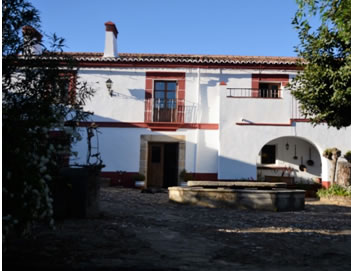 Unlike the aborted African trips our Spanish trip was done and dusted on the computer within one afternoon. We would fly out of Heathrow Terminal 5 on the 30/03/2017 arriving in Terminal 4, Madrid some 2hrs later. Our carrier would be Iberia, we would pick up a hire car from Alamo and travel some 256k to our accommodation at Casa Rural El Recuerdo, the rest of the trip would happen as we went along. Although we are happy to point bins and camera at anything that flies, we did have some major objectives, we wanted to get some decent photos of both bustards and sandgrouse; we also wanted to improve the quality of our pictures of Pipits and Larks those LBJs that are often overlooked, ignored or misidentified, birds that should be in abundance on the vast plains around Trujillo and Caceres. Hopefully they should be more approachable as they try to satisfy the demands of their young. The large array of raptors the area holds was also a consideration. Trujillo is a beautiful Spanish medieval town with a wonderful central square that holds colonies of Lesser Kestrel and Pallid Swift as well as dozens of small tavernas and restaurants.
Unlike the aborted African trips our Spanish trip was done and dusted on the computer within one afternoon. We would fly out of Heathrow Terminal 5 on the 30/03/2017 arriving in Terminal 4, Madrid some 2hrs later. Our carrier would be Iberia, we would pick up a hire car from Alamo and travel some 256k to our accommodation at Casa Rural El Recuerdo, the rest of the trip would happen as we went along. Although we are happy to point bins and camera at anything that flies, we did have some major objectives, we wanted to get some decent photos of both bustards and sandgrouse; we also wanted to improve the quality of our pictures of Pipits and Larks those LBJs that are often overlooked, ignored or misidentified, birds that should be in abundance on the vast plains around Trujillo and Caceres. Hopefully they should be more approachable as they try to satisfy the demands of their young. The large array of raptors the area holds was also a consideration. Trujillo is a beautiful Spanish medieval town with a wonderful central square that holds colonies of Lesser Kestrel and Pallid Swift as well as dozens of small tavernas and restaurants.
DIARY and DAILY REVIEW
Day 1
A very early start saw us leaving home a little after 04-30 for our 1.5hr drive to Heathrow. Our flight left bang on time, which is not our normal experience with flights from there. The flight took a shade over 2hrs. We arrived in Madrid to clear skies and warmish temperatures. We picked up our hire car and then managed to get hopelessly lost in the cat’s cradle of motorways that encompass this large city. Several heated discussions and entirely by chance we eventually found a sign for A5 Badajoz – this was our route south. After circumnavigating Madrid for the second time and tempers cooling we were eventually heading in the right direction. Our drive took almost 4hrs; in 2012 it took us 2. Eventually we arrived at our destination a little weary and in need of a little T L C, this came in the form of a cuppa and a small nap. Our evening meal and subsequent evening meals were a little disappointing and not of the standard we remembered from our previous visit; day 1 was concluded with a very good night’s sleep.
Day 2
As the sun doesn’t really rise before 08-00 we had time for a leisurely breakfast of cereals and toast. The weather was overcast and cold, with the temperature gauge in the car registering a meagre 12°C. Having had a full day travelling the previous day we decided to bird locally. Our first port of call was the Belen Plains, a twenty minute drive from our accommodation Both Corn Bunting and Crested Lark were abundant, small flocks of Spanish Sparrow, Goldfinch and Linnet were encountered at regular intervals along with the occasional Calandra, Thekla and Crested Larks. Raptors were also much in evidence with both Red & Black Kites, both Kestrels, Buzzard and Griffin Vultures holding our attention. A lone male Great Bustard was seen displaying in the distance, too far for meaningful photography. With the temperatures reaching the giddy heights of 15 degrees by noon we slowly retraced our steps stopping for a coffee and tapas at a bar just outside Trujillo. With the sun eventually breaking through we visited the Santa Marta track which was a major disappointment: it appears they are turning it into a 6 lane highway. Here we spent a very disappointing afternoon, returning to our accommodation at 18-00hrs: another very disappointing evening meal concluded our second day.
Day 3
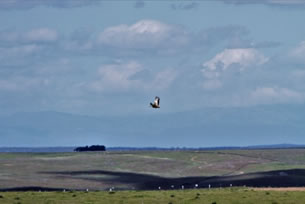 Today dawned very misty with visibility below 50 metres. We had planned to visit the rice fields today, so even with our host Martin’s misgivings that it probably wouldn’t be a very productive day, we set off. The rice fields are now bone dry and are being prepared for sowing so our quarry of aquatic species was a non-starter. Our first stop was the Campo Lugar road which proved fairly productive. With the early mist now gone many Great Bustards were seen displaying. With several birds seen flying in, reminiscent of a blackcock leck, many of the grounded birds were already strutting their stuff. Alas, the vast majority were beyond our camera lens range as usual. From here we ventured south into the rice growing area and, as correctly prophesied by Martin, they produced very little. Several hours trawling through the myriad of dirt tracks with scant reward, a single Green Sandpiper was the only wader encountered encouraging us to return to our accommodation by mid-afternoon.
Today dawned very misty with visibility below 50 metres. We had planned to visit the rice fields today, so even with our host Martin’s misgivings that it probably wouldn’t be a very productive day, we set off. The rice fields are now bone dry and are being prepared for sowing so our quarry of aquatic species was a non-starter. Our first stop was the Campo Lugar road which proved fairly productive. With the early mist now gone many Great Bustards were seen displaying. With several birds seen flying in, reminiscent of a blackcock leck, many of the grounded birds were already strutting their stuff. Alas, the vast majority were beyond our camera lens range as usual. From here we ventured south into the rice growing area and, as correctly prophesied by Martin, they produced very little. Several hours trawling through the myriad of dirt tracks with scant reward, a single Green Sandpiper was the only wader encountered encouraging us to return to our accommodation by mid-afternoon.
Day 4
Having birded the plains for the past few days we took Martin’s advice and birded around Jaraicejo, an area of differing habitats, from large open plains covered with Spanish Broom to wooded valley bottoms and high passes with panoramic 360 degree vistas stretching to the horizon. Our first stop was the plains noted for a large population of Subalpine Warblers, from here we visited a viewing point where we got shots of a Three-toed Treecreeper but little else. A walk down a wooded hillside also proved unproductive with only both Great and Blue Tits seen along with several Chaffinches. Our last stop for the day was a picnic area adjacent to an ancient and defunct bridge over a small river. Our stay here was brief as there were more wasp sounding motocross bikes than there were birds.
Day 5
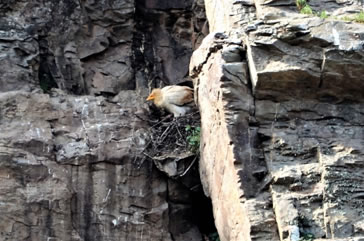 Today we visited the Monfragüe National Park; our first stop was Peña Falcón – an imposing rock massif where raptors abound. As soon as we opened the car door we realised we had not come dressed for the occasion. With just lightweight fleeces, the icy wind blew straight through our clothing leaving our teeth chattering within minutes. We walked down to the viewing point only to find dozens of birders clad to scale Everest. A quick scan of Peña produced all 3 European Vultures and our first Black Stork of the trip. We returned to the relative warmth of the car and drove the dozen or so kilometres to the well-established Imperial Eagles’ nest. Parking here is at a premium and the nearest free parking spot was a forced march away. Undaunted we drove back over the dam and parked in the public car park and contented ourselves with watching the goings on of both Egyptian Vultures and Black Kites.
Today we visited the Monfragüe National Park; our first stop was Peña Falcón – an imposing rock massif where raptors abound. As soon as we opened the car door we realised we had not come dressed for the occasion. With just lightweight fleeces, the icy wind blew straight through our clothing leaving our teeth chattering within minutes. We walked down to the viewing point only to find dozens of birders clad to scale Everest. A quick scan of Peña produced all 3 European Vultures and our first Black Stork of the trip. We returned to the relative warmth of the car and drove the dozen or so kilometres to the well-established Imperial Eagles’ nest. Parking here is at a premium and the nearest free parking spot was a forced march away. Undaunted we drove back over the dam and parked in the public car park and contented ourselves with watching the goings on of both Egyptian Vultures and Black Kites. 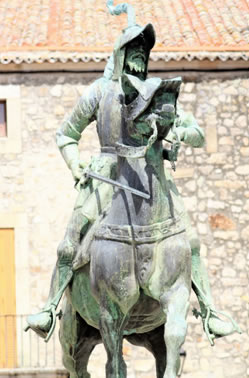 Both birds appeared to have decided to nest close to each other and were not really comfortable with the arrangement. Every time the Egyptian Vulture got airborne it was immediately mobbed by the kites.
Both birds appeared to have decided to nest close to each other and were not really comfortable with the arrangement. Every time the Egyptian Vulture got airborne it was immediately mobbed by the kites.
With hypothermia now a real possibility we decided to call it quits and console ourselves with a late lunch in the central square in Trujillo. Retracing our steps we stopped at the Monroy road where we spent an hour looking for both bustards and sandgrouse without success. We parked in the outskirts of Trujillo and walked in. A couple of plates chosen from the Spanish Menu were shared together with a side of chips and bread. Having had the pleasure of several meals in this wonderful square over the years, we were perplexed at the dearth of Lesser Kestrels and both Common and Pallid Swifts whose calls and screeches accompanied previous visits.
We returned to our accommodation and birded around the village.
Day 6
An hour’s drive north up the motorway saw us at the Embalse de Almaraz-Arrocampo reserve. This reserve is situated in a shallow valley surrounded by hills and snow-capped mountains, it is reached via a high modern bridge spanning the river that leads from the reserve. From this vantage point the whole reserve is visible and on the day we arrived was enveloped in an eerie almost apocalyptic mist. We both looked at each other, enquiring is this normal? With other road users going about their business without any apparent concern we decided life as we know it wasn’t going to end and proceeded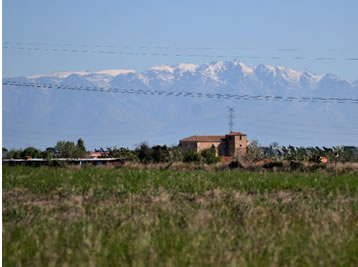 . By the time we reached the reserve the evil mist had disappeared leaving a blue cloudless sky.
. By the time we reached the reserve the evil mist had disappeared leaving a blue cloudless sky.
Arrocampo is a nature reserve created by the requirements of the adjacent atomic power station for water to cool its reactors. The wetland created has been turned into reed fringed shallow pools holding typical wetland species for early spring. Bittern breed on the reserve, although they were uncooperative, as do Purple Heron, Purple Swamphen, Black-winged Stilt, Savi’s Warbler, Zitting Cisticola and Black-shouldered Kite amongst the more common species. Savi’s Warbler were much more cooperative and a species required for our photographic bird library. A Little Owl with a cataract in one eye garnered a sympathetic response.
Day 7
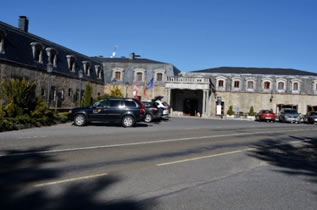 Today was moving on day, and although we hadn’t booked anything Martin suggested the Gredos Mountains which were back toward Madrid, something we needed to be mindful of as we had to be at the airport no later than 10.00 hrs for our flight home. With Martin pre-booking our room in the Parador de Gredos we set off for the 2hr drive. As our journey passed Arrocampo we decided to pop in and try again for the Black-winged Kites that nest on the reserve, we had no success the day before, even after being shown the nest location on the reserve map. Again we fared no better today, and so by mid-afternoon we had arrived at the imposing ex hunting lodge that is the Parador. Snow-capped mountains above vast pine forests filled the vista from our room, a truly impressive location.
Today was moving on day, and although we hadn’t booked anything Martin suggested the Gredos Mountains which were back toward Madrid, something we needed to be mindful of as we had to be at the airport no later than 10.00 hrs for our flight home. With Martin pre-booking our room in the Parador de Gredos we set off for the 2hr drive. As our journey passed Arrocampo we decided to pop in and try again for the Black-winged Kites that nest on the reserve, we had no success the day before, even after being shown the nest location on the reserve map. Again we fared no better today, and so by mid-afternoon we had arrived at the imposing ex hunting lodge that is the Parador. Snow-capped mountains above vast pine forests filled the vista from our room, a truly impressive location.
Day 8
 With us both now suffering from air flight flu, today was to be a leisurely affair; breakfast was taken at 10.00hrs, and we were on the road within half an hour, we drove the 18k to Plataforma de Gredos, a parking area above the snow line. From this point people were setting off to walk the high tops, others had skies strapped to their backs. Shod in little more than crocks we contented ourselves in birding the area around the car park. A Chamois stood sentinel like on a rock well above the car park. A Crag Martin was found building a nest in a small shelter nearby. Rock Bunting, Black Redstart and Dunnock were happy to mingle with the parked cars, whilst a steady stream of Griffon Vultures floated over the snow-capped peaks. A bird that looked for all the world like a female House Sparrow was calling from a roadside barrier from which it soon alighted and perched in a nearby tree; the single note monotonous call certainly did not belong to Passer domesticus – the bird was eventually identified as Rock Sparrow, another nice bird for the trip. Having been treated to probably the finest pasta dish I have ever had the day before, tonight I was served the worst soup I have ever eaten: it was an amalgam of unidentifiable gelatinous lumps and small rock hard pieces of who knows what. The longer it remained in front of me the more gelatinous it became. The menu said Garlic Soup!!
With us both now suffering from air flight flu, today was to be a leisurely affair; breakfast was taken at 10.00hrs, and we were on the road within half an hour, we drove the 18k to Plataforma de Gredos, a parking area above the snow line. From this point people were setting off to walk the high tops, others had skies strapped to their backs. Shod in little more than crocks we contented ourselves in birding the area around the car park. A Chamois stood sentinel like on a rock well above the car park. A Crag Martin was found building a nest in a small shelter nearby. Rock Bunting, Black Redstart and Dunnock were happy to mingle with the parked cars, whilst a steady stream of Griffon Vultures floated over the snow-capped peaks. A bird that looked for all the world like a female House Sparrow was calling from a roadside barrier from which it soon alighted and perched in a nearby tree; the single note monotonous call certainly did not belong to Passer domesticus – the bird was eventually identified as Rock Sparrow, another nice bird for the trip. Having been treated to probably the finest pasta dish I have ever had the day before, tonight I was served the worst soup I have ever eaten: it was an amalgam of unidentifiable gelatinous lumps and small rock hard pieces of who knows what. The longer it remained in front of me the more gelatinous it became. The menu said Garlic Soup!!
Day 9
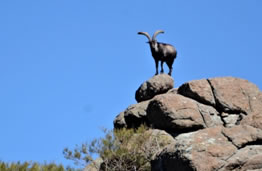 Having had a very bad night due to the lurgy we again treated ourselves to a late breakfast before embarking on one of the forest trails that radiated from the Parador. Feeling a little delicate we chose a 3 kilometre circular route which we thought would only take at the most a couple of hour’s very steady birding. After almost 3hrs we retraced our steps arriving back at the hotel totally knackered. The only bright spot during the walk was the Bonelli’s Eagle that flew low overhead and the welcome sight of the Parador on our return. A cup of tea and a rest prepared us for another assault on the restaurant’s menu which did not alter for the duration of our stay.
Having had a very bad night due to the lurgy we again treated ourselves to a late breakfast before embarking on one of the forest trails that radiated from the Parador. Feeling a little delicate we chose a 3 kilometre circular route which we thought would only take at the most a couple of hour’s very steady birding. After almost 3hrs we retraced our steps arriving back at the hotel totally knackered. The only bright spot during the walk was the Bonelli’s Eagle that flew low overhead and the welcome sight of the Parador on our return. A cup of tea and a rest prepared us for another assault on the restaurant’s menu which did not alter for the duration of our stay.
Day 10
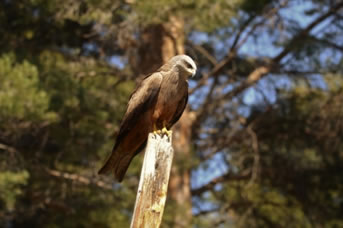 With the lurgy not abating we toyed with the idea of confining ourselves to bed; however after a very, very late breakfast we drove the couple of kilometres to Hostel Rural Almanzur. This was a small hotel Martin had tried to book us in during our stay at Recuerdo but they didn’t open until the Easter week. This Hostel is used by many birding groups using the area because it is owned and run by a wildlife photographer who has built a bird photography hide into the hostel. A large plate glass window looked over a small feeding station and drinking/bathing trough. Although he wasn’t open he had kindly said we could use the hide if we wanted. Birds came thick and fast, Blackbird, Robin, House Sparrow, Black Redstart, Serin, Rock Sparrow, Green and Greater –spotted Woodpeckers, White Wagtail and then the cherry on the cake, a pair of Black Kite feeding on offal just feet from the window. It’s surprising how a sight like this can make you feel so much better, even if for a few minutes. Having spent a couple of hours in the hide we thanked the owner very much and returned to our accommodation, returning immediately to wimp mode.
With the lurgy not abating we toyed with the idea of confining ourselves to bed; however after a very, very late breakfast we drove the couple of kilometres to Hostel Rural Almanzur. This was a small hotel Martin had tried to book us in during our stay at Recuerdo but they didn’t open until the Easter week. This Hostel is used by many birding groups using the area because it is owned and run by a wildlife photographer who has built a bird photography hide into the hostel. A large plate glass window looked over a small feeding station and drinking/bathing trough. Although he wasn’t open he had kindly said we could use the hide if we wanted. Birds came thick and fast, Blackbird, Robin, House Sparrow, Black Redstart, Serin, Rock Sparrow, Green and Greater –spotted Woodpeckers, White Wagtail and then the cherry on the cake, a pair of Black Kite feeding on offal just feet from the window. It’s surprising how a sight like this can make you feel so much better, even if for a few minutes. Having spent a couple of hours in the hide we thanked the owner very much and returned to our accommodation, returning immediately to wimp mode.
Day 11
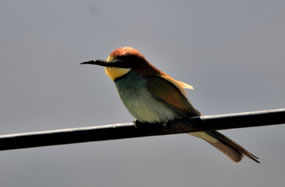 With wimp mode still prevalent we again availed ourselves a very late breakfast before embarking on a short drive to a local hermitage a couple of kilometres off the beaten track: little new was seen apart from half a dozen or so Bee-eaters which were sitting on wires adjacent to the main road. We returned back to the Parador for the final time as we were leaving for Madrid early the next day.
With wimp mode still prevalent we again availed ourselves a very late breakfast before embarking on a short drive to a local hermitage a couple of kilometres off the beaten track: little new was seen apart from half a dozen or so Bee-eaters which were sitting on wires adjacent to the main road. We returned back to the Parador for the final time as we were leaving for Madrid early the next day.
SUMMARY
The holiday was not the most successful we have ever had, we dipped out on the majority of the birds we wanted to photograph. This was due to poor preparation on our part and sheer bad luck. The Santa Marta de Magasca track has always proved very productive in the past with sandgrouse, and both bustards seen previously. This time the track was a major construction site with a new road being built right through to Monroy rendering birding impossible. Although it wasn’t wall-to-wall sunshine the weather was kind with some sunny warm days and no rain, a blessing as we spent the second half of our holiday high in the Gredos Mountains.
MOANS, GROANS AND MEMORABLE MOMENTS
Moan – The standard of food during this holiday, especially at the Parador. Any vegetable accompaniment was generally cold and we had the worst soup we have ever been served. We ordered a Sweet Chestnut pudding the one night and a cheesecake the next night only to be served the same pudding! Apple tart and ice cream served hot one night and then cold the second. A beef burger again served barely warm accompanied by cold chips, we could go on. No wonder the car-park was full and the restaurant was empty.
Groan – Our flight to Madrid with Iberia: the flight was full so our hand luggage was labelled to be stowed under the seat – unfortunately we had to spend the 2hr flight with rucksacks placed between our feet. The cost of our flight was £248 return per person. This was a flight with no food or inflight entertainment, the only concession was a few kilos more luggage. Iberia/B.A. short-haul are now budget airlines in all but name: how much profit do these companies think is acceptable?
Moan – The lurgy we are convinced we contracted on the outbound flight and from which we are still suffering 2 weeks later. A course of antibiotics has been necessary to conquer this particular bug. Again, reducing the cabin airflow saves money, but does absolutely nothing for customer comfort or, more importantly, health.
Groan – Our abject failure in obtaining photos of many of our target birds.
Moan – Although Wi-Fi was apparently available throughout the Parador it was almost non-existent in the bedrooms. One receptionist said she would get the engineer to tweak the bandwidth in our room. Another receptionist said there was nothing that could be done!
Memorable Moments
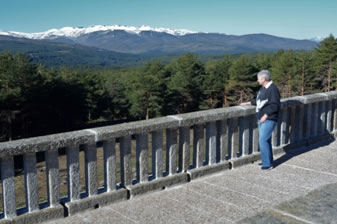 Managing to tease out a Savi’s Warbler into a clear area of reeds in order to get a reasonable photo. The only new photo for the library.
Managing to tease out a Savi’s Warbler into a clear area of reeds in order to get a reasonable photo. The only new photo for the library.
The Black Kites that came down to feed on carrion just feet from us in the hide at Almanzur Hostel.
The breathtaking location and views from the Parador de Gredos.
Many thanks to Martin for his help in securing our accommodation on leaving his hostel. Martin always finds time to answer queries or partake in information no matter how busy he is.
Our Bird List was very modest at just 98 species; no lifers were seen with just 1 new bird photo added to our photographic bird library, although several improved photos of existing birds were also added.
